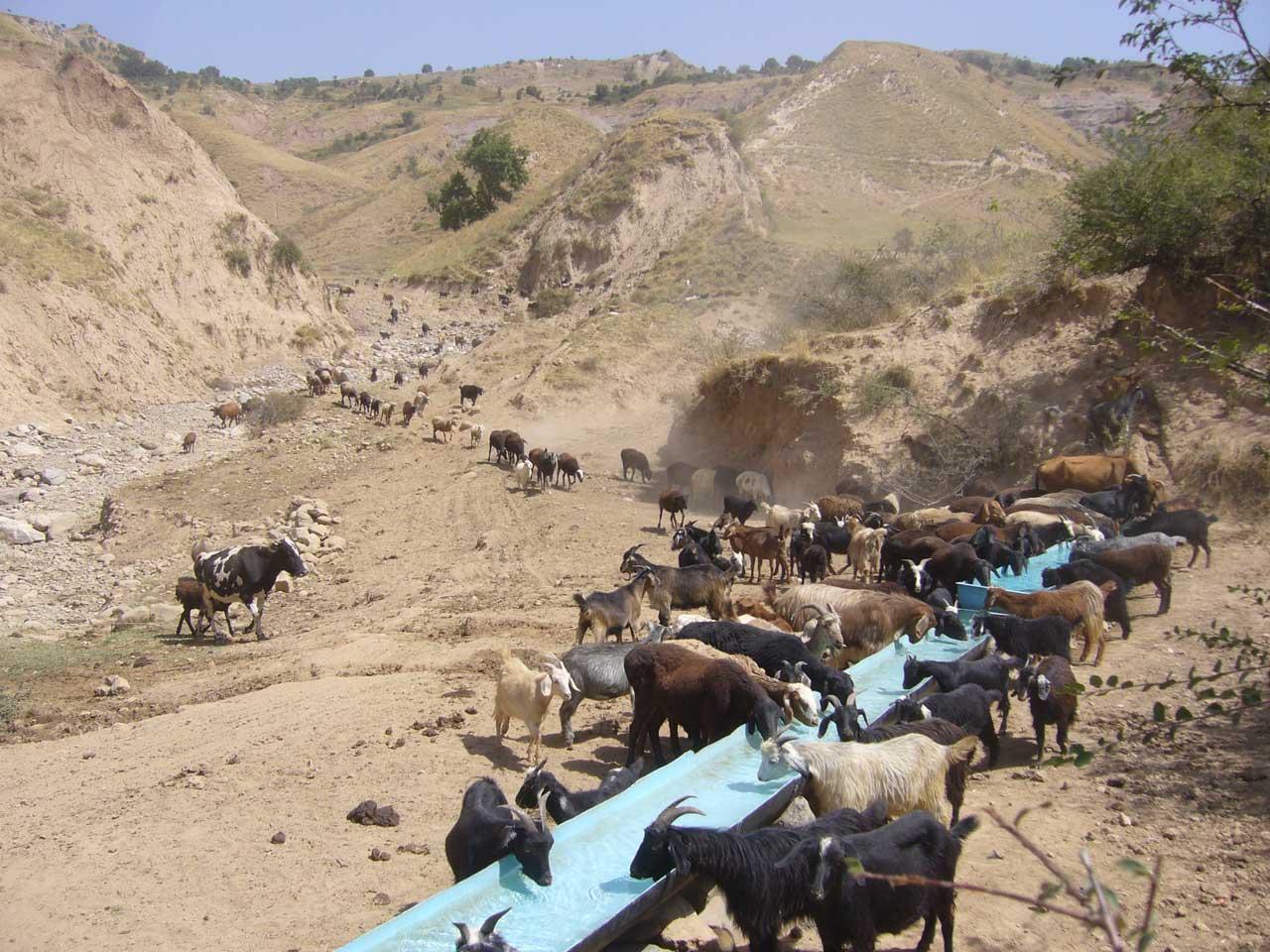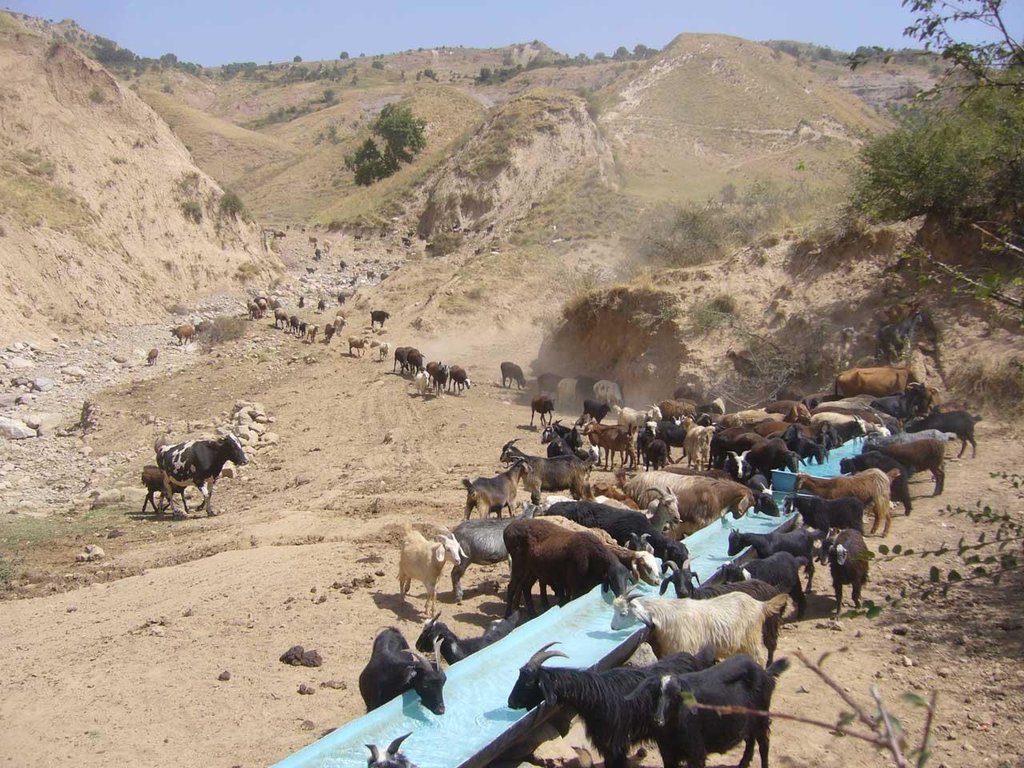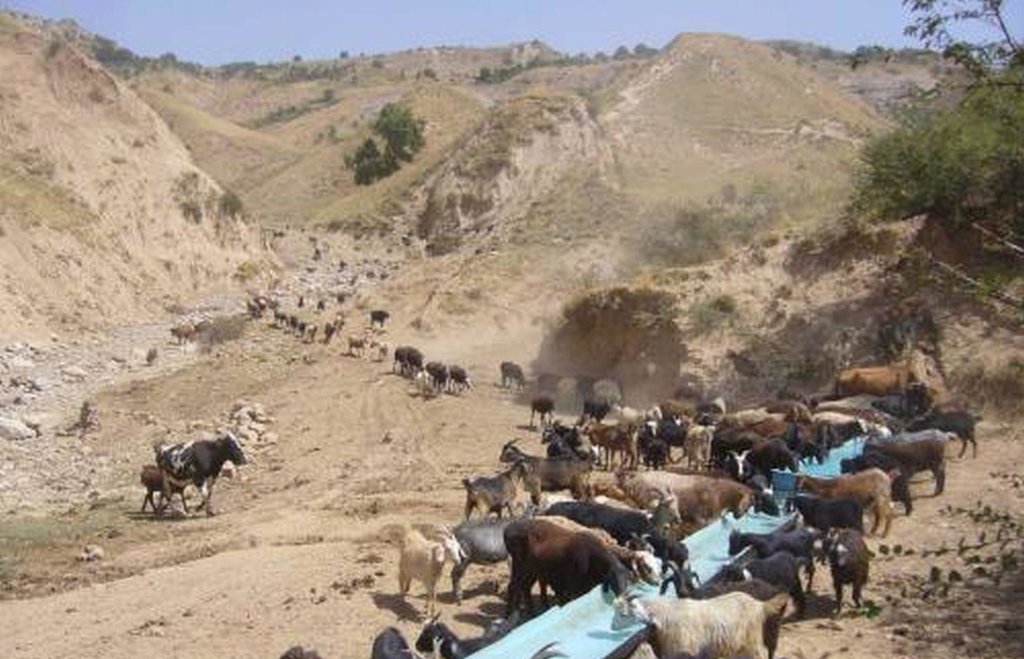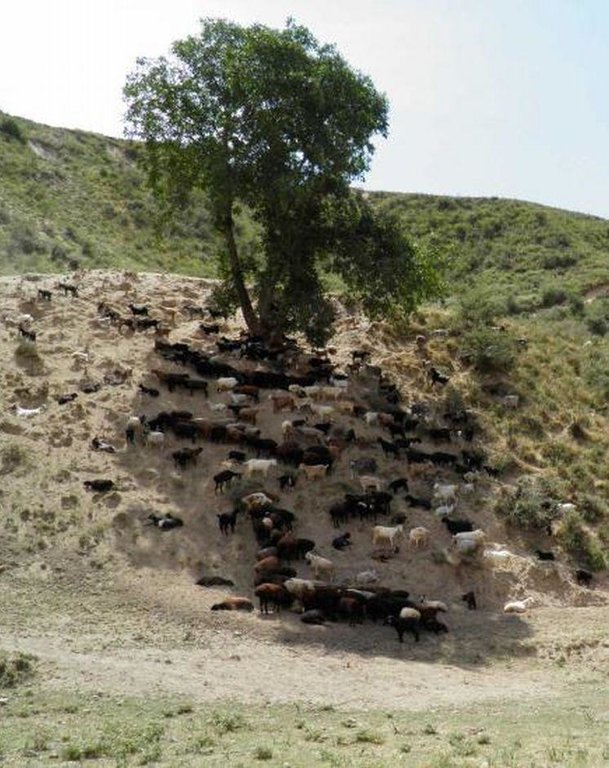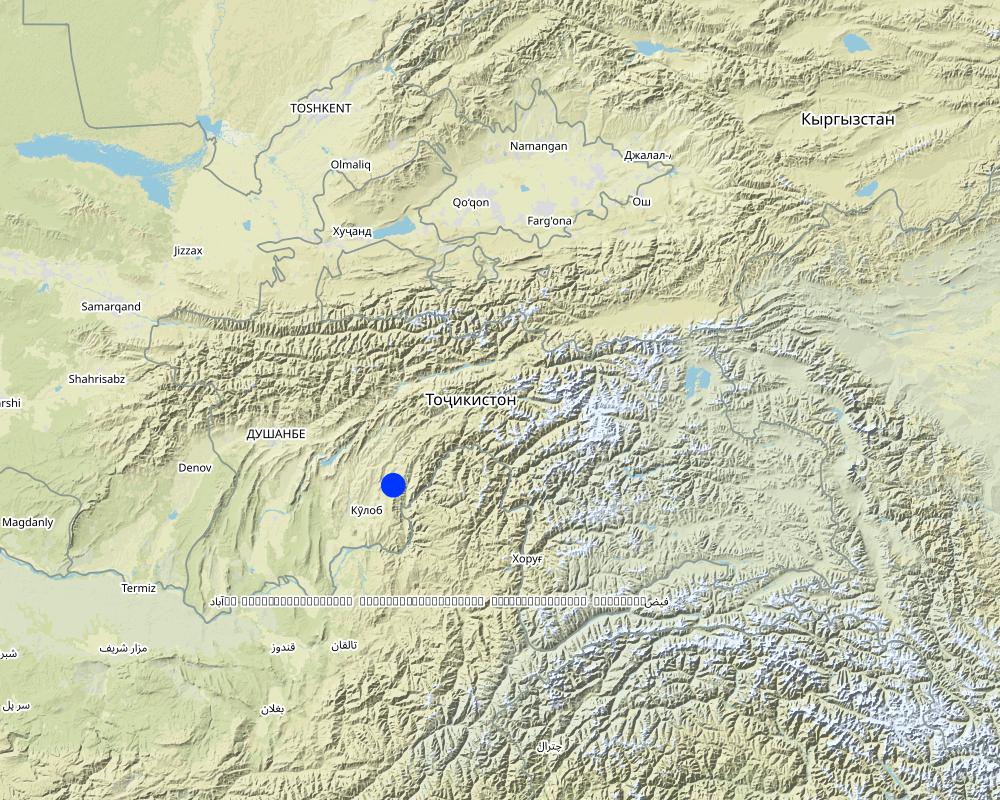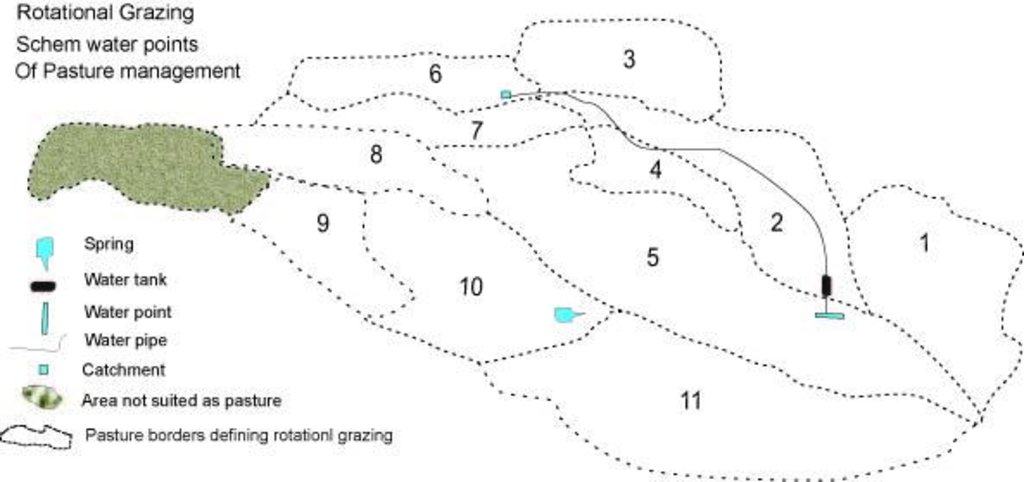Rotational grazing supported by additional water points [ប្រទេសតាហ្ស៊ីគីស្ថាន]
- ការបង្កើត៖
- បច្ចុប្បន្នភាព
- អ្នកចងក្រង៖ Sa'dy Odinashoev
- អ្នកកែសម្រួល៖ –
- អ្នកត្រួតពិនិត្យច្រើនទៀត៖ Deborah Niggli, David Streiff, Alexandra Gavilano, Joana Eichenberger
Чаронидани даврави бо нуктахои обнуши ва чойхои дамгири
technologies_1519 - ប្រទេសតាហ្ស៊ីគីស្ថាន
- សង្ខេបជា PDF
- សេចក្តីសង្ខេបពេញលេញជាទម្រង់ PDF សម្រាប់បោះពុម្ព
- សេចក្តីសង្ខេបពេញលេញទម្រង់អ៊ីនធឺនេត
- សេចក្តីសង្ខេបពេញលេញ (មិនមានទម្រង់ជាក់លាក់)
- Rotational grazing supported by additional water points: 21 ខែ សីហា ឆ្នាំ 2019 (inactive)
- Rotational grazing supported by additional water points: 2 ខែ វិច្ឆិកា ឆ្នាំ 2021 (public)
- Rotational grazing supported by additional water points: 8 ខែ សីហា ឆ្នាំ 2017 (inactive)
- Rotational grazing supported by additional water points: 19 ខែ កក្កដា ឆ្នាំ 2017 (inactive)
- Rotational grazing supported by additional water points: 14 ខែ មិនា ឆ្នាំ 2017 (inactive)
ពិនិត្យមើលគ្រប់ផ្នែក
ពង្រីកមើលទាំងអស់ បង្រួមទាំងអស់1. ព័ត៌មានទូទៅ
1.2 ព័ត៌មានលម្អិតពីបុគ្គលសំខាន់ៗ និងស្ថាប័នដែលចូលរួមក្នុងការវាយតម្លៃ និងចងក្រងឯកសារនៃបច្ចេកទេស
អ្នកជំនាញឯកទេស SLM:
ឈ្មោះគម្រោងដែលបានចងក្រងឯកសារ/ វាយតម្លៃលើបច្ចេកទេស (បើទាក់ទង)
Knowledge Management for Integrated Watershed Management and Disaster Risk Reduction (SDC / IWSM)ឈ្មោះគម្រោងដែលបានចងក្រងឯកសារ/ វាយតម្លៃលើបច្ចេកទេស (បើទាក់ទង)
Pilot Program for Climate Resilience, Tajikistan (WB / PPCR)ឈ្មោះអង្គភាពមួយ (ច្រើន) ដែលបានចងក្រងឯកសារ/ វាយតម្លៃបច្ចេកទេស (បើទាក់ទង)
CARITAS (Switzerland) - ប្រទេសស្វ៊ីសឈ្មោះអង្គភាពមួយ (ច្រើន) ដែលបានចងក្រងឯកសារ/ វាយតម្លៃបច្ចេកទេស (បើទាក់ទង)
CDE Centre for Development and Environment (CDE Centre for Development and Environment) - ប្រទេសស្វ៊ីស1.3 លក្ខខណ្ឌទាក់ទងទៅនឹងការប្រើប្រាស់ទិន្នន័យដែលបានចងក្រងតាមរយៈ វ៉ូខេត
អ្នកចងក្រង និង(បុគ្គលសំខាន់ៗ)យល់ព្រមទទួលយកនូវលក្ខខណ្ឌនានាទាក់ទងទៅនឹងការប្រើប្រាស់ទិន្នន័យដែលបានចងក្រងតាមរយៈវ៉ូខេត:
បាទ/ចា៎
1.4 សេចក្តីប្រកាសស្តីពីចីរភាពនៃការពណ៌នាពីបច្ចេកទេស
តើបច្ចេកទេសដែលបានពណ៌នានេះមានបញ្ហាដែលផ្តោតលើការធ្លាក់ចុះគុណភាពដី, បើដូច្នេះវាមិនអាចត្រូវបានប្រកាសថាជាបច្ចេកទេសនៃការគ្រប់គ្រងប្រកបដោយចីរភាពទេ?
ទេ
1.5 ការយោងទៅលើកម្រងបញ្ជីសំណួរ (មួយ ឬច្រើន) នៃវិធីសាស្ត្រផ្សព្វផ្សាយ SLM (ដែលបានចងក្រងដោយទស្សនៈពិភពលោកស្តីពីវិធីសាស្ត្រ និងបច្ចេកទេសងអភិរក្ស WOCAT)
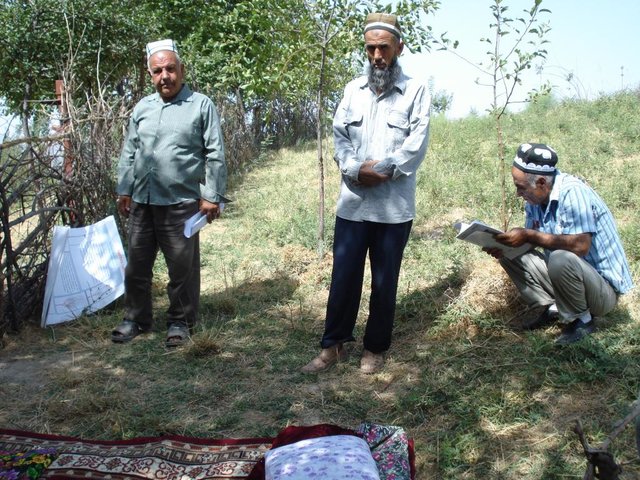
Livestock Committee at Village Level [ប្រទេសតាហ្ស៊ីគីស្ថាន]
Livestock committees were established with the goal to improve livestock health as well as natural resource management in the watersheds where the village pastures were situated. Livestock committees in the Muminabad district are organised at village level and coordinate their activities through the registered livestock association at district level.
- អ្នកចងក្រង៖ Sa'dy Odinashoev
2. ការពណ៌នាពីបច្ចេកទេស SLM
2.1 ការពណ៌នាដោយសង្ខេបពីបច្ចេកទេស
និយមន័យបច្ចេកទេស:
After the end of the Soviet era, an increased number of livestock with less grazing land available, has led to the deterioration of the pastures, including overgrazing, reduction of plant diversity, poor livestock health and soil erosion. To tackle the problem, Caritas Switzerland together with livestock committees at village level introduced rotational grazing supported by extra water points and rest places.
2.2 ការពណ៌នាលម្អិតពីបច្ចេកទេស
ការពណ៌នា:
When in 2009 the project started in the two watersheds of Fayzabad and Gesh in Muminabad district, the communities had identified insufficient livestock water points in the pastures, and poor pasture management as top priorities concerning natural resource management in the watersheds. At that time, one of the biggest problems for livestock and herders was the difficult access to water when grazing the daily pastures above the villages. At lunch time, herds had to walk long distances (4-5 kilometers) and actually had to come back to the villages for drinking water. Climbing twice a day to the pasture costs the cattle a lot of energy leading to a yearly loss of up to 40-50 kg, according to a Caritas Switzerland study. One initial measure to improve the condition of the livestock was therefore to establish water points in the pastures. At first, water sources that supply water throughout the year were identified.
Purpose of the Technology: The water is now collected in a cement catchment, from where it is channelled through pipes to the drinking water points for animals. In some cases water tanks are placed above water points, to collect water and to distribute it to the water points. Additionally, rest places were found for the livestock, where they can have a rest in the shade after drinking water on hot summer days.
In conjunction to the establishment of water points, a rotational grazing scheme was introduced. The pasture land in the watershed was divided into ten parts and in each plot the animals were allowed to graze for five to eight days, assuring longer growing times for grass on specific pastures and thus increasing the quantity of grass and the quality of the pastures.
Establishment / maintenance activities and inputs: Livestock committees, consisting of five people, were organised. They took the lead in developing appropriate grazing schemes and discussing the location of the water points with the villagers. They are in charge of further maintenance of the water points, and the daily organisation of the rotational grazing. One of the five committee members is the shepherd. Every morning he accompanies the herd and checks the water points and the rest places. Once a month he collects one Somoni from each family to cover costs arising from this method of pasture management in the watershed.
Natural / human environment: The technology is implemented on pasture land where animal drinking water is readily available only in spring, and during the rest of the year the distances to water sources are long. Daily pastures in stony terrain with steep slopes and pastures situated higher up are difficult to reach. The livestock grazing on common grazing land are controlled by the head shepherd with the task of coordinating the different helpers and having overall responsibility for herding the livestock.
2.3 រូបភាពនៃបច្ចេកទេស
2.5 ប្រទេស/តំបន់/ទីតាំងកន្លែង ដែលបច្ចេកទេសត្រូវបានអនុវត្ត និងបានគ្រប់ដណ្តប់ដោយការវាយតម្លៃនេះ
ប្រទេស:
ប្រទេសតាហ្ស៊ីគីស្ថាន
តំបន់/រដ្ឋ/ខេត្ត:
Tajikistan, Khatlon
បញ្ជាក់បន្ថែមពីលក្ខណៈនៃទីតាំង:
Muminabad
បញ្ជាក់ពីការសាយភាយនៃបច្ចេកទេស:
- ត្រូវបានផ្សព្វផ្សាយត្រឹមតំបន់មួយ
ប្រសិនបើមិនច្បាស់ពីទំហំផ្ទៃដី សូមធ្វើការប៉ាន់ប្រម៉ាណ:
- 100-1,000 គម2
មតិយោបល់:
Total area covered by the SLM Technology is 93.74 km2.
11 projects applied this technology, however, in the cost section of this case study costs are calculated for only one of these 11 projects (Faizabad watersheds)
Map
×2.6 កាលបរិច្ឆេទនៃការអនុវត្ត
ប្រសិនបើមិនច្បាស់ឆ្នាំ សូមបញ្ជាក់កាលបរិច្ឆេទដែលប្រហាក់ប្រហែល:
- តិចជាង 10ឆ្នាំមុន (ថ្មី)
2.7 ការណែនាំពីបច្ចេកទេស
សូមបញ្ជាក់តើបច្ចេកទេសត្រូវបានណែនាំឱ្យអនុវត្តដោយរបៀបណា:
- តាមរយៈការបង្កើតថ្មីរបស់អ្នកប្រើប្រាស់ដី
3. ចំណាត់ថ្នាក់នៃបច្ចេកទេស SLM
3.1 គោលបំណងចម្បង (១ ឬច្រើន) នៃបច្ចេកទេសនេះ
- កាត់បន្ថយ, បង្ការ, ស្តារឡើងវិញនូវការធ្លាក់ចុះគុណភាពដី
3.2 ប្រភេទដីប្រើប្រាស់មួយប្រភេទ (ច្រើនប្រភេទ) ដែលបានអនុវត្តបច្ចេកទេស

ដីដាំដំណាំ
- ដំណាំរយៈពេលវែង (មិនមែនឈើ)
- ប្រភេទដើមឈើធំៗ និងដើមឈើតូចៗ
ដំណាំរយៈពេលវែង (មិនមែនឈើ) - បញ្ជាក់ប្រភេទដំណាំ:
- ផ្លែប៊ឺរី
ប្រភេទដើមឈើធំៗ និងដើមឈើតូចៗ - បញ្ជាក់ប្រភេទ:
- ដើមឈើយកគ្រាប់ (brazil nuts, pistachio, walnuts, almonds, etc.)
ចំនួនសារដែលដាំដំណាំក្នុងមួយឆ្នាំ:
- 1
សូមបញ្ជាក់:
Longest growing period in days: 145Longest growing period from month to month: March-September

ដីសម្រាប់ចិញ្ចឹមសត្វ
វាលស្មៅធំៗ:
- ពាក់កណ្តាលពនេចរ
- rotational grazing
ប្រភេទសត្វ:
- សត្វពពែ
- Livestock density (if relevant): > 100 LU /km2

ដីព្រៃ/ដីដាំដើមឈើ
ផលិតផល និងសេវាកម្ម:
- ផលិតផលព្រៃផ្សេងៗ
មតិយោបល់:
Major land use problems (compiler’s opinion): Animal trampling and little vegetation cover, wind erosion, water erosion.
Major land use problems (land users’ perception): Bad pastures, bad access to water points.
Semi-nomadism / pastoralism: rotational grazing
Grazingland comments: Healthy livestock go out to the summer pastures and cows that are used for milk stay in the village along with the sick animals.
Type of grazing system comments: Healthy livestock go out to the summer pastures and cows that are used for milk stay in the village along with the sick animals.
3.4 ការផ្គត់ផ្គង់ទឹក
ការផ្គត់ផ្គង់ទឹកនៅកន្លែងអនុវត្តបច្ចេកទេស:
- ទឹកភ្លៀង
3.5 ក្រុម SLM ដែលបច្ចេកទេសស្ថិតនៅក្នុង
- កសិរុក្ខកម្ម (pastoralism) និងការគ្រប់គ្រងដីសម្រាប់ចិញ្ចឹមសត្វ
- ធ្វើឱ្យប្រសើរឡើងគម្របដី/ ដំណាំគម្របដី
3.6 វិធានការ SLM ដែលបញ្ចូលនូវបច្ចេកទេស

វិធានការរុក្ខជាតិ
- V1: ឈើធំៗ និងដើមឈើតូចៗ

វិធានការគ្រប់គ្រង
- M2: ការផ្លាស់ប្តូរការគ្រប់គ្រង/ កម្រិតអាំងតង់ស៊ីតេ
មតិយោបល់:
Main measures: management measures
Secondary measures: vegetative measures
Type of vegetative measures: in blocks
3.7 កំណត់ប្រភេទនៃការធ្លាក់ចុះគុណភាពដីសំខាន់ៗដែលបច្ចេកទេសនេះបានដោះស្រាយ

ការហូរច្រោះដីដោយសារទឹក
- Wt: ការបាត់ដីស្រទាប់លើដោយការហូរច្រោះ

ការបាត់ដីដោយសារខ្យល់
- Et: ការបាត់បង់ដីស្រទាប់លើ

ការធ្លាក់ចុះសារធាតុគីមីក្នុងដី
- Cn: ការថយចុះជីជាតិ និងកាត់បន្ថយបរិមាណសារធាតុសរីរាង្គ (មិនកើតឡើងដោយការហូរច្រោះទេ)

ការបាត់បង់រូបសាស្ត្រនៃដី
- Pc: ការហាប់ណែន

ការធ្លាក់ចុះជីវសាស្ត្រនៃដី
- Bc: ការថយចុះនូវគម្របរុក្ខជាតិ

ការបាត់បង់ទឹក
- Ha: ការថយចុះសំណើមដី
មតិយោបល់:
Main type of degradation addressed: Wt: loss of topsoil / surface erosion, Et: loss of topsoil, Bc: reduction of vegetation cover
Secondary types of degradation addressed: Cn: fertility decline and reduced organic matter content, Pc: compaction, Ha: aridification
Main causes of degradation: overgrazing (bad management of pastures), population pressure (many animals in the pastures)
Secondary causes of degradation: inputs and infrastructure: (roads, markets, distribution of water points, other, …)
3.8 ការពារ កាត់បន្ថយ ឬស្តារឡើងវិញនៃការធ្លាក់ចុះគុណភាពដី
បញ្ជាក់ពីគោលដៅរបស់បច្ចេកទេស ដែលផ្តោតទៅការធ្លាក់ចុះគុណភាពដី:
- ការការពារការធ្លាក់ចុះគុណភាពដី
មតិយោបល់:
Main goals: prevention of land degradation
4. បច្ចេកទេសជាក់លាក់ សកម្មភាពអនុវត្ត ធាតុចូល និងថ្លៃដើម
4.1 គំនូសបច្ចេកទេសនៃបច្ចេកទេសនេះ
លក្ខណៈពិសេសនៃបច្ចេកទេស (ទាក់ទងនឺងគំនូរបច្ចេកទេស):
Rotational grazing map for pasture management.
Location: Muminabad district. Muminabad, Khatlon, Tajikistan
Date: 2010-12-27
Technical knowledge required for field staff / advisors: high
Technical knowledge required for land users: moderate
Main technical functions: increase in organic matter, increase of infiltration
Secondary technical functions: improvement of ground cover
In blocks
Vegetative material: T : trees / shrubs
Number of plants per (ha): 200
Vertical interval within rows / strips / blocks (m): 5.00
Width within rows / strips / blocks (m): 6.00
Trees/ shrubs species: maple
Fruit trees / shrubs species: mulberry, wallnut
Slope (which determines the spacing indicated above): 80.00%
Change of land use practices / intensity level: from grazing land to rotational grazing land
Layout change according to natural and human environment: water points
ឈ្មោះអ្នកនិពន្ធ:
Sa'dy Odinashoev, Muminabad
4.2 ព័ត៌មានទូទៅដែលពាក់ព័ន្ធនឹងការគណនាធាតុចូល និងថ្លៃដើម
កំណត់រូបិយប័ណ្ណសម្រាប់ថ្លៃដើម:
- ដុល្លារ
កំណត់ថ្លៃឈ្នួលជាមធ្យមនៃការជួលកម្លាំងពលកម្មក្នុងមួយថ្ងៃ:
6.00
4.3 សកម្មភាពបង្កើត
| សកម្មភាព | រយៈពេល (រដូវកាល) | |
|---|---|---|
| 1. | Planting trees to create rest places for livestock | spring |
| 2. | Planting trees to create rest places for livestock | |
| 3. | water points | 2 months |
| 4. | construction of the pipeline from the spring to the water points | 1 month |
| 5. | catchment device on the spring | |
| 6. | catchment device on the spring | |
| 7. | calculating carring capacity and number of days of grazing period on each plot | |
| 8. | calculating carring capacity and number of days of grazing period on each plot |
4.4 ថ្លៃដើម និងធាតុចូលដែលត្រូវការសម្រាប់ការបង្កើតបច្ចេកទេស
| បញ្ជាក់ពីធាតុចូល | ឯកតា | បរិមាណ | ថ្លៃដើមក្នុងមួយឯកតា | ថ្លៃធាតុចូលសរុប | % នៃថ្លៃដើមដែលចំណាយដោយអ្នកប្រើប្រាស់ដី | |
|---|---|---|---|---|---|---|
| កម្លាំងពលកម្ម | Planting trees incl. seeds | Persons/day | 20,0 | 5,5 | 110,0 | 20,0 |
| កម្លាំងពលកម្ម | Waterpoints construction labour | Persons/day | 160,0 | 5,5 | 880,0 | 100,0 |
| កម្លាំងពលកម្ម | Pipeline Construction incl. Watertanks etc | pipeline | 1,0 | 6648,0 | 6648,0 | 30,0 |
| សម្ភារៈ | Catchement device | device | 1,0 | 353,0 | 353,0 | 20,0 |
| ថ្លៃដើមសរុបក្នុងការបង្កើតបច្ចេកទេស | 7991,0 | |||||
| ថ្លៃដើមសរុបក្នុងការបង្កើតបច្ចេកទេសគិតជាដុល្លារ | 7991,0 | |||||
ប្រសិនបើអ្នកប្រើប្រាស់ដីមិនមានថ្លៃដើម 100% សូមបញ្ជាក់ថានរណាដែលចំណាយថ្លៃដើមដែលនៅសល់:
Caritas
4.5 សកម្មភាពថែទាំ
| សកម្មភាព | ពេលវេលា/ ភាពញឹកញាប់ | |
|---|---|---|
| 1. | Protecting young trees with dead branches from thorny bushes | 2-3 years |
| 2. | Protecting young trees with dead branches from thorny bushes | |
| 3. | Watering of trees (done by sheperd) | 1-2 years |
| 4. | Watering of trees (done by sheperd) | |
| 5. | rotational grazing and checking the water catchment and distribution system (salary for shepherd) | 8 months |
4.6 កំណត់ថ្លៃដើមសម្រាប់ការថែទាំ/ សកម្មភាពរបស់បច្ចេកទេស (ក្នុងរយៈពេលមួយឆ្នាំ)
| បញ្ជាក់ពីធាតុចូល | ឯកតា | បរិមាណ | ថ្លៃដើមក្នុងមួយឯកតា | ថ្លៃធាតុចូលសរុប | % នៃថ្លៃដើមដែលចំណាយដោយអ្នកប្រើប្រាស់ដី | |
|---|---|---|---|---|---|---|
| កម្លាំងពលកម្ម | rotational grazing and checking the water catchment and distribution system | ha | 800,0 | 0,7975 | 638,0 | |
| កម្លាំងពលកម្ម | Protecting young trees with dead branches from thorny bushes | Persons/day | 20,0 | 5,5 | 110,0 | |
| ថ្លៃដើមសរុបសម្រាប់ការថែទាំដំណាំតាមបច្ចេកទេស | 748,0 | |||||
| ថ្លៃដើមសរុបសម្រាប់ការថែទាំដំណាំតាមបច្ចេកទេសគិតជាដុល្លារ | 748,0 | |||||
មតិយោបល់:
Machinery/ tools: spade, possible water tap, shovels, spades
The costs were calculated for infrastructure establishment, labour etc. applying to the whole area of 800 ha.
4.7 កត្តាសំខាន់បំផុតដែលមានឥទ្ធិពលដល់ការចំណាយ
ពណ៌នាពីកត្តាប៉ះពាល់ចម្បងៗទៅលើថ្លៃដើម:
Distance to the water source, and the availability of high resolution satellite maps (the technology is cheaper if maps are available because the planning process gets facilitated).
5. លក្ខណៈបរិស្ថានធម្មជាតិ និងមនុស្ស
5.1 អាកាសធាតុ
បរិមាណទឹកភ្លៀងប្រចាំឆ្នាំ
- < 250 មម
- 251-500 មម
- 501-750 មម
- 751-1,000 មម
- 1,001-1,500 មម
- 1,501-2,000 មម
- 2,001-3,000 មម
- 3,001-4,000 មម
- > 4,000 មម
តំបន់កសិអាកាសធាតុ
- មានភ្លៀងមធ្យម
Thermal climate class: temperate
5.2 សណ្ឋានដី
ជម្រាលជាមធ្យម:
- រាបស្មើ (0-2%)
- ជម្រាលតិចតួច (3-5%)
- មធ្យម (6-10%)
- ជម្រាលខ្ពស់បន្តិច (11-15%)
- ទីទួល (16-30%)
- ទីទួលចោត (31-60%)
- ទីទួលចោតខ្លាំង (>60%)
ទម្រង់ដី:
- ខ្ពង់រាប
- កំពូលភ្នំ
- ជម្រាលភ្នំ
- ជម្រាលទួល
- ជម្រាលជើងភ្នំ
- បាតជ្រលងភ្នំ
តំបន់តាមរយៈកម្ពស់ :
- 0-100 ម
- 101-500 ម
- 501-1,000 ម
- 1,001-1,500 ម
- 1,501-2,000 ម
- 2,001-2,500 ម
- 2,501-3,000 ម
- 3,001-4,000 ម
- > 4,000 ម
មតិយោបល់ និងបញ្ចាក់បន្ថែមអំពីសណ្ឋានដី :
Landforms occure also in ridges.
Slopes on average are also moderate sometimes.
5.3 ដី
ជម្រៅដីជាមធ្យម:
- រាក់ខ្លាំង (0-20 សម)
- រាក់ (21-50 សម)
- មធ្យម (51-80 សម)
- ជ្រៅ (81-120 សម)
- ជ្រៅខ្លាំង (> 120 សម)
វាយនភាពដី (ស្រទាប់លើ):
- មធ្យម (ល្បាយ, ល្បាប់)
សារធាតុសរីរាង្គនៅស្រទាប់ដីខាងលើ:
- ខ្ពស់ (>3%)
- មធ្យម (1-3%)
បើអាចសូមភ្ជាប់ការពណ៌នាពីដីឱ្យបានច្បាស់ ឬព័ត៌មានដែលអាចទទួលបាន ឧ. ប្រភេទដី, pH ដី/ ជាតិអាស៊ីត, សមត្ថភាពផ្លាស់ប្តូរកាចុង, វត្តមាននីត្រូសែន, ភាពប្រៃ ។ល។:
Soil depth on average can somtimes be deep.
Soil fertility is low on spring pastures, medium where the animals are grazing and high on the top of the watershed.
Topsoil organic matter is on the top high and medium in the middle.
Soil drainage / infiltration is good on the top of the watershed and medium in the middle of the watershed.
Soil water storage capacity is high on the top, medium in the middle and very low on the bottom.
5.4 ទឹកដែលអាចទាញមកប្រើប្រាស់បាន និងគុណភាពទឹក
នីវ៉ូទឹកក្រោមដី:
5-50 ម
ទឹកលើដីដែលអាចទាញយកប្រើប្រាស់បាន:
កម្រិតមធ្យម
គុណភាពទឹក (មិនបានធ្វើប្រត្តិកម្ម):
ទឹកពិសារដែលមានគុណភាពល្អ
មតិយោបល់ និងលក្ខណៈពិសេសផ្សេងៗទៀតលើគុណភាព និងបរិមាណទឹក :
Ground water table is everywhere 5-50 m
Water quality (untreated) is als sometime poor.
5.5 ជីវៈចម្រុះ
ភាពសម្បូរបែបនៃប្រភេទ:
- កម្រិតមធ្យម
5.6 លក្ខណៈនៃអ្នកប្រើប្រាស់ដីដែលអនុវត្តបច្ចេកទេស
ទីផ្សារនៃប្រព័ន្ធផលិតកម្ម:
- សម្រាប់ហូបក្នុងគ្រួសារ (ផ្គត់ផ្គង់ខ្លួនឯង)
ចំណូលក្រៅកសិកម្ម:
- ច្រើនជាង 50% នៃចំណូល
កម្រិតជីវភាព:
- មិនល្អខ្លាំង
- មធ្យម
ឯកជន ឬក្រុម:
- ជាក្រុម/ សហគមន៍
យេនឌ័រ:
- ស្ត្រី
- បុរស
សូមបញ្ជាក់ពីលក្ខណៈពាក់ព័ន្ធផ្សេងទៀតអំពីអ្នកប្រើប្រាស់ដី:
Land users applying the Technology are mainly common / average land users
Difference in the involvement of women and men: The men do most of the work out in the fields, such as carrying water and walking to the fields.
Population density: < 10 persons/km2
Annual population growth: 1% - 2%
2% of the land users are poor.
Off-farm income specification: most families have remittances from Russia
5.7 ទំហំផ្ទៃដីជាមធ្យមនៃដីប្រើប្រាស់ដោយអ្នកប្រើប្រាស់ដី ក្នុងការអនុវត្តបច្ចេកទេស
- < 0.5 ហិកតា
- 0.5-1 ហិកតា
- 1-2 ហិកតា
- 2-5 ហិកតា
- 5-15 ហិកតា
- 15-50 ហិកតា
- 50-100 ហិកតា
- 100-500 ហិកតា
- 500-1,000 ហិកតា
- 1,000-10,000 ហិកតា
- > 10,000 ហិកតា
តើផ្ទៃដីនេះចាត់ទុកជាទំហំកម្រិតណាដែរ ខ្នាតតូច មធ្យម ឬខ្នាតធំ (ធៀបនឹងបរិបទតំបន់)?
- ខ្នាតធំ
មតិយោបល់:
Common grazing land (500ha / 400 households)
5.8 ភាពជាម្ចាស់ដី កម្មសិទ្ធប្រើប្រាស់ដី និងកម្មសិទ្ធប្រើប្រាស់ទឹក
ភាពជាម្ចាស់ដី:
- ភូមិ
កម្មសិទ្ធិប្រើប្រាស់ដី:
- ជាក្រុម (មានដែនកំណត់)
កម្មសិទ្ធប្រើប្រាស់ទឹក:
- ជាក្រុម (មានដែនកំណត់)
5.9 ការប្រើប្រាស់សេវាកម្ម និងហេដ្ឋារចនាសម្ព័ន្ធ
សុខភាព:
- មិនល្អ
- មធ្យម
- ល្អ
ការអប់រំ:
- មិនល្អ
- មធ្យម
- ល្អ
ជំនួយបច្ចេកទេស:
- មិនល្អ
- មធ្យម
- ល្អ
ការងារ (ឧ. ការងារក្រៅកសិដ្ឋាន):
- មិនល្អ
- មធ្យម
- ល្អ
ទីផ្សារ:
- មិនល្អ
- មធ្យម
- ល្អ
ថាមពល:
- មិនល្អ
- មធ្យម
- ល្អ
ផ្លូវ និងការដឹកជញ្ជូន:
- មិនល្អ
- មធ្យម
- ល្អ
ទឹកផឹក និងអនាម័យ:
- មិនល្អ
- មធ្យម
- ល្អ
សេវាកម្មហិរញ្ញវត្ថុ:
- មិនល្អ
- មធ្យម
- ល្អ
6. ផលប៉ះពាល់ និងការសន្និដ្ឋាន
6.1 ផលប៉ះពាល់ក្នុងបរិវេណអនុវត្តបច្ចេកទេសដែលកើតមាន
ផលប៉ះពាល់លើសេដ្ឋកិច្ចសង្គម
ផលិតផល
ផលិតកម្មចំណីសត្វ
មតិយោបល់/ ការបញ្ជាក់:
in the upper area more grass
គុណភាពចំណីសត្វ
មតិយោបល់/ ការបញ្ជាក់:
perenial plants
ផលិតកម្មសត្វ
មតិយោបល់/ ការបញ្ជាក់:
milk, meat
ទឹកដែលអាចទាញមកប្រើប្រាស់បាន និងគុណភាពទឹក
ទឹកបរិភោគដែលអាចទាញយកមកប្រើប្រាស់បាន
មតិយោបល់/ ការបញ្ជាក់:
No water available previously
គុណភាពទឹកបរិភោគ
មតិយោបល់/ ការបញ្ជាក់:
No water available previously
ទឹកប្រើប្រាស់សម្រាប់ស្រោចស្រព
ចំណូល និងថ្លៃដើម
ការចំណាយលើធាតុចូលកសិកម្ម
មតិយោបល់/ ការបញ្ជាក់:
less money spent on vets
ចំណូលក្នុងកសិដ្ឋាន
មតិយោបល់/ ការបញ្ជាក់:
more milk prduced
បន្ទុកការងារ
មតិយោបល់/ ការបញ្ជាក់:
less walking for herders
ផលប៉ះពាល់ទៅលើសេដ្ឋកិច្ចសង្គមផ្សេងៗ
pasture area
មតិយោបល់/ ការបញ្ជាក់:
road to the new pastures
Water payments
មតិយោបល់/ ការបញ្ជាក់:
No payment previously
ផលប៉ះពាល់ទៅលើវប្បធម៌សង្គម
ឱកាសវប្បធម៍
ស្ថាប័នសហគមន៍
មតិយោបល់/ ការបញ្ជាក់:
livestock commitee have respect in the village
ចំណេះដឹង SLM / ការធ្លាក់ចុះគុណភាពដី
មតិយោបល់/ ការបញ្ជាក់:
villagers
ការកាត់បន្ថយជម្លោះ
មតិយោបល់/ ការបញ្ជាក់:
Previously a lot of conflict in this area, regular meeting have helped reduce these.
ស្ថានភាពក្រុមដែលមានបញ្ហាក្នុងសង្គម និងសេដ្ឋកិច្ច
មតិយោបល់/ ការបញ្ជាក់:
Empowerment of women and marginalised groups. Women are involved in the workshops
collaboration between different stakeholders
មតិយោបល់/ ការបញ្ជាក់:
watershed group in livestock committee in the village
Livelihood and human well-being
ផលប៉ះពាល់ទៅលើអេកូឡូស៊ី
វដ្តទឹក/លំហូរ
បរិមាណទឹក
មតិយោបល់/ ការបញ្ជាក់:
water points
គុណភាពទឹក
មតិយោបល់/ ការបញ្ជាក់:
filtering in the spring
លំហូរទឹកលើផ្ទៃដី
រំហួត
ដី
សំណើមដី
មតិយោបល់/ ការបញ្ជាក់:
more grass
គម្របដី
ការបាត់បង់ដី
មតិយោបល់/ ការបញ្ជាក់:
Cattle do not need to walk over soem areas
សារធាតុសរីរាង្គដី/ការបូនក្រោមដី
ជីវចម្រុះ៖ ដំណាំ, សត្វ
ភាពសម្បូរបែបនៃរុក្ខជាតិ
មតិយោបល់/ ការបញ្ជាក់:
due to better management
ភាពសម្បូរបែបនៃទីជំរក
មតិយោបល់/ ការបញ្ជាក់:
more plants
ការកាត់បន្ថយហានិភ័យនៃគ្រោះមហន្តរាយ និងគ្រោះអាកាសធាតុ
ការបំភាយនៃកាបូន និងឧស្ម័នផ្ទះកញ្ចក់
មតិយោបល់/ ការបញ្ជាក់:
grass
6.2 ផលប៉ះពាល់ក្រៅបរិវេណអនុវត្តបច្ចេកទេសដែលកើតមាន
ទឹកជំនន់ខ្សែទឹកខាងក្រោម
កំណកល្បាប់ខ្សែទឹកខាងក្រោម
ខ្យល់នាំយកនូវធូរលី
ខូចខាតដល់ស្រែអ្នកជិតខាង
6.3 ភាពប្រឈម និងភាពរួសនៃបច្ចេកទេសទៅនឹងការប្រែប្រួលអាកាសធាតុ និងគ្រោះអាកាសធាតុ/ គ្រោះមហន្តរាយ (ដែលដឹងដោយអ្នកប្រើប្រាស់ដី)
ការប្រែប្រួលអាកាសធាតុ
ការប្រែប្រួលអាកាសធាតុ
| រដូវកាល | កើនឡើង ឬថយចុះ | លក្ខណៈឆ្លើយតបនៃបច្ចេកទេសទៅនឹងការប្រែប្រួលអាកាសធាតុ | |
|---|---|---|---|
| សីតុណ្ហភាពប្រចាំឆ្នាំ | កើនឡើង | ល្អ |
គ្រោះអាកាសធាតុ (មហន្តរាយ)
គ្រោះមហន្តរាយធម្មជាតិ
| លក្ខណៈឆ្លើយតបនៃបច្ចេកទេសទៅនឹងការប្រែប្រួលអាកាសធាតុ | |
|---|---|
| ព្យុះភ្លៀងតាមតំបន់ | ល្អ |
| ព្យុះកំបុតត្បូងតាមតំបន់ | ល្អ |
គ្រោះមហន្តរាយអាកាសធាតុ
| លក្ខណៈឆ្លើយតបនៃបច្ចេកទេសទៅនឹងការប្រែប្រួលអាកាសធាតុ | |
|---|---|
| រាំងស្ងួត | ល្អ |
គ្រោះមហន្តរាយទឹក
| លក្ខណៈឆ្លើយតបនៃបច្ចេកទេសទៅនឹងការប្រែប្រួលអាកាសធាតុ | |
|---|---|
| ទឹកជំនន់ទូទៅ (ទន្លេ) | ល្អ |
ផលវិបាកដែលទាក់ទងនឹងបរិយាកាសផ្សេងៗទៀត
ផលវិបាកដែលទាក់ទងនឹងបរិយាកាសផ្សេងៗទៀត
| លក្ខណៈឆ្លើយតបនៃបច្ចេកទេសទៅនឹងការប្រែប្រួលអាកាសធាតុ | |
|---|---|
| កាត់បន្ថយពេលដាំដុះ | ល្អ |
មតិយោបល់:
Increase in temperature --> install more water points
Increase or decrease in rainfall --> adapt the rotational grazing system
6.4 ការវិភាគថ្លៃដើម និងអត្ថប្រយោជន៍
តើផលចំណេញ និងថ្លៃដើមត្រូវបានប្រៀបធៀបគ្នាយ៉ាងដូចម្តេច (ទស្សនៈរបស់អ្នកប្រើប្រាស់ដី)?
រយៈពេលខ្លី:
វិជ្ជមាន
រយៈពេលវែង:
វិជ្ជមាន
តើផលចំណេញ និងការថែទាំ/ ជួសជុលត្រូវបានប្រៀបធៀបគ្នាយ៉ាងដូចម្តេច (ទស្សនៈរបស់អ្នកប្រើប្រាស់ដី)?
រយៈពេលខ្លី:
វិជ្ជមាន
រយៈពេលវែង:
វិជ្ជមាន
6.5 ការទទួលយកបច្ចេកទេស
- > 50%
បើអាច សូមបញ្ជាក់ពីបរិមាណ (ចំនួនគ្រួសារ និង/ ឬតំបន់គ្របដណ្តប់):
500 households in an area of 93.7 km^2 (10 persons/km^2)
ក្នុងចំណោមគ្រួសារទាំងអស់ដែលបានអនុវត្តបច្ចេកទេស តើមានប៉ុន្មានគ្រួសារដែលចង់ធ្វើដោយខ្លួនឯង ដោយមិនទទួលបានសម្ភារៈលើកទឹកចិត្ត/ប្រាក់ឧបត្ថម្ភ?:
- 11-50%
មតិយោបល់:
80% of land user families have adopted the Technology with external material support
480 land user families have adopted the Technology with external material support
Comments on acceptance with external material support: nine other villages would like to adopt this technology
There is no trend towards spontaneous adoption of the Technology
6.7 ភាពខ្លាំង/ គុណសម្បត្តិ/ ឱកាសនៃបច្ចេកទេស
| ភាពខ្លាំង/ គុណសម្បត្តិ/ ឱកាសនៅកន្លែងរបស់អ្នកប្រើប្រាស់ដី |
|---|
|
More water points How can they be sustained / enhanced? Less risks for their animals |
| ភាពខ្លាំង/ គុណសម្បត្តិ/ ឱកាស ទស្សនៈរបស់បុគ្គលសំខាន់ៗ |
|---|
| Rotational grazing to improve grass cover |
|
Better incomes for the farmer and at the same time pasture ressources are better managed How can they be sustained / enhanced? more meetings and workshops |
6.8 ភាពខ្សោយ/ គុណវិបត្តិ/ ហានិភ័យនៃបច្ចេកទេស និងវិធីសាស្ត្រដោះស្រាយ
| ភាពខ្សោយ/ គុណវិបត្តិ/ ហានិភ័យ ទស្សនៈរបស់អ្នកប្រើប្រាស់ដី | តើបច្ចេកទេសទាំងនោះបានដោះស្រាយបញ្ហាដូចម្តេច? |
|---|---|
| difficult to work with maps | one day workshop |
| one person had to share their water with the rest of the village | organise meetings --> good communication, show the advantages to everybody |
| ភាពខ្សោយ/ គុណវិបត្តិ/ ហានិភ័យ ទស្សនៈរបស់អ្នកចងក្រងឬបុគ្គលសំខាន់ៗ | តើបច្ចេកទេសទាំងនោះបានដោះស្រាយបញ្ហាដូចម្តេច? |
|---|---|
| One year for such a project is too short | project should be extended to 2-3 years as within three years the trees in the rest places will be well established |
| only one water point it is not enough to improve soil and water conservation | rotational grazing and rest places have to be implemented together with water points |
| young trees have to be protected | Using PET bottles or thorny bushes |
7. ឯកសារយោង និងវេបសាយ
7.1 វិធីសាស្ត្រ/ ប្រភពនៃព័ត៌មាន
- តាមការចុះទីវាល ការស្រាវជ្រាវនៅទីវាល
- ការសម្ភាសន៍ជាមួយអ្នកប្រើប្រាស់ដី
តើពេលណាដែលទិន្នន័យបានចងក្រង (នៅទីវាល)?
16/07/2010
ការតភ្ជាប់ និងម៉ូឌុល
ពង្រីកមើលទាំងអស់ បង្រួមទាំងអស់ការតភ្ជាប់

Livestock Committee at Village Level [ប្រទេសតាហ្ស៊ីគីស្ថាន]
Livestock committees were established with the goal to improve livestock health as well as natural resource management in the watersheds where the village pastures were situated. Livestock committees in the Muminabad district are organised at village level and coordinate their activities through the registered livestock association at district level.
- អ្នកចងក្រង៖ Sa'dy Odinashoev
ម៉ូឌុល
គ្មានម៉ូឌុល


